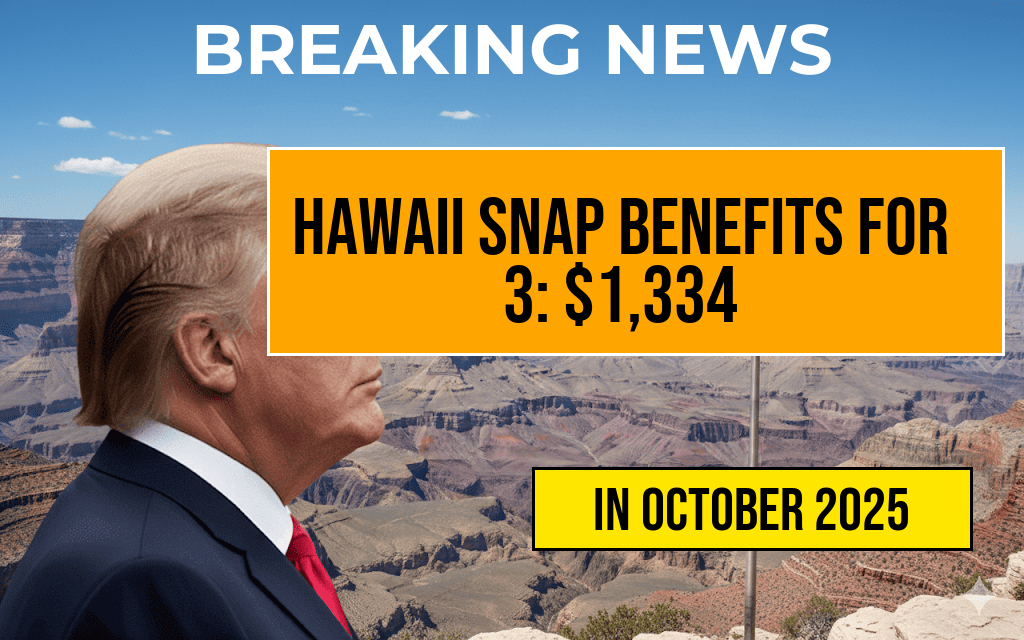Hawaii SNAP Benefits for a Family of Three Surpass Mainland Payments by $349, Reaching $1,334
Families participating in the Supplemental Nutrition Assistance Program (SNAP) in Hawaii are receiving significantly higher benefits compared to their counterparts across the mainland United States. For a typical family of three, the monthly SNAP allotment in Hawaii now totals approximately $1,334, surpassing the national average by around $349. This disparity reflects Hawaii’s elevated living costs, particularly in housing, utilities, and food expenses, which the state’s SNAP program aims to address through increased benefits. The federal government sets baseline assistance levels, but states like Hawaii can supplement these figures based on local cost-of-living adjustments, leading to notable differences in benefit amounts.
Understanding the Factors Behind Hawaii’s Higher SNAP Benefits
The stark contrast between Hawaii’s SNAP benefits and those of other states stems from multiple economic factors unique to the island state. Hawaii’s cost of living consistently ranks among the highest nationwide, driven by elevated housing prices, utility costs, and transportation expenses. According to data from U.S. Census Bureau, the median housing price in Hawaii exceeds $800,000, significantly more than the national median.
Recognizing these economic challenges, the U.S. Department of Agriculture (USDA) allows states to tailor SNAP benefits based on regional costs. Hawaii’s Department of Human Services adjusts benefit calculations accordingly, resulting in higher monthly allotments. These adjustments aim to ensure that recipients can maintain adequate nutrition despite the higher prices for essential goods and services.
How SNAP Benefits Are Calculated in Hawaii
The calculation process involves multiple factors, including household income, size, and regional living costs. The federal government establishes a standard benefit level, but Hawaii’s adjustments compensate for local economic conditions. The current maximum monthly SNAP benefit for a family of three in Hawaii is $1,334, reflecting a substantial increase over the national average of approximately $985.
To illustrate this, consider the following table comparing SNAP maximum benefits across select states:
| State | Maximum Benefit |
|---|---|
| Hawaii | $1,334 |
| California | $740 |
| New York | $835 |
| Texas | $658 |
| Florida | $467 |
While the federal baseline provides a foundation, state-specific adjustments recognize regional economic realities, and Hawaii’s figures exemplify this approach.
Implications for Recipients and Policy Considerations
The higher SNAP benefits in Hawaii highlight ongoing policy efforts to combat food insecurity amid soaring living costs. For families of three, an increase of nearly $350 in monthly assistance can significantly impact their ability to access nutritious food and stabilize household budgets.
However, these elevated benefits also raise questions about the sustainability and equity of assistance programs nationwide. Critics argue that such disparities could complicate efforts to standardize aid levels and may require ongoing reassessment as economic conditions evolve. Conversely, advocates emphasize that regional adjustments are essential to reflect true living costs, ensuring that aid effectively alleviates hardship where it is most acute.
Broader Context and Future Outlook
The recent data underscores the importance of tailoring social safety net programs to local realities. As inflation persists and housing affordability remains a challenge in Hawaii, policymakers may consider further adjustments or additional support measures. The state’s higher SNAP benefits also serve as a reminder of the broader economic pressures faced by residents, prompting discussions about comprehensive strategies to address housing, healthcare, and employment issues.
For more insights into SNAP and regional benefit structures, resources such as the USDA Food and Nutrition Service provide detailed information on program guidelines and regional adaptations.
Frequently Asked Questions
What is the average SNAP benefit amount for a family of three in Hawaii?
The average SNAP benefit for a family of three in Hawaii reaches approximately $1,334.
How does the SNAP benefit in Hawaii compare to the mainland?
The SNAP benefit in Hawaii is about $349 higher than the average amount provided in the mainland.
What factors influence the higher SNAP benefits in Hawaii?
The higher SNAP benefits in Hawaii are primarily due to the state’s higher cost of living and food prices, which are factored into the benefit calculations.
Who is eligible for SNAP benefits in Hawaii?
Eligibility for SNAP benefits in Hawaii is based on household income, size, and other criteria set by the Supplemental Nutrition Assistance Program.
How can families in Hawaii apply for SNAP benefits?
Families in Hawaii can apply for SNAP benefits online through the Hawaii Department of Human Services website or visit local offices for assistance.

Leave a Reply